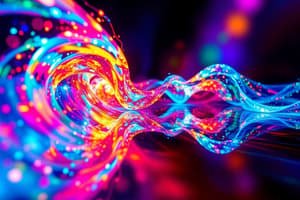Podcast
Questions and Answers
What is the mathematical relationship described by the Einstein photoelectric equation?
What is the mathematical relationship described by the Einstein photoelectric equation?
- Energy of photon and kinetic energy of emitted electron
- Kinetic energy of emitted electron and work function
- Frequency of light and work function
- Kinetic energy of emitted electron and frequency of light (correct)
What did Robert A. Millikan successfully demonstrate in 1914 related to the photoelectric effect?
What did Robert A. Millikan successfully demonstrate in 1914 related to the photoelectric effect?
- Kinetic energy of emitted electrons increases linearly with the frequency of light (correct)
- The photoelectric effect is not impacted by frequency of light
- Frequency of light has no effect on emitting electrons
- Kinetic energy of emitted electrons is inversely proportional to the frequency of light
What practical application is associated with determining the frequency of incident light using the photoelectric effect?
What practical application is associated with determining the frequency of incident light using the photoelectric effect?
- Color filtering
- Heat insulation
- Photovoltaic cells (correct)
- Magnetic field measurement
Which fundamental concept did the photoelectric effect experiment provide strong evidence for?
Which fundamental concept did the photoelectric effect experiment provide strong evidence for?
What did the photoelectric effect reveal about the nature of light?
What did the photoelectric effect reveal about the nature of light?
The discovery of wave-particle duality by Albert Einstein challenged the then-dominant ______ theory of light
The discovery of wave-particle duality by Albert Einstein challenged the then-dominant ______ theory of light
Quantum mechanics provides the framework for understanding ______ and particle-wave duality
Quantum mechanics provides the framework for understanding ______ and particle-wave duality
The complementarity principle, proposed by Niels Bohr, states that certain pairs of experimental methods used to study natural phenomena are ______ exclusive
The complementarity principle, proposed by Niels Bohr, states that certain pairs of experimental methods used to study natural phenomena are ______ exclusive
The dual nature of radiation and matter has led to the development of quantum computers, quantum cryptography, and ______ physics
The dual nature of radiation and matter has led to the development of quantum computers, quantum cryptography, and ______ physics
The behavior of subatomic particles, such as electrons and photons, is influenced by wave-particle duality and ______ principle
The behavior of subatomic particles, such as electrons and photons, is influenced by wave-particle duality and ______ principle
Flashcards are hidden until you start studying
Study Notes
Unveiling the Dual Nature of Radiation and Matter through the Photoelectric Effect
The concept of the dual nature of radiation and matter, also known as wave-particle duality, is a fundamental principle in modern physics. It asserts that all particles and waves can exhibit properties of both waves and particles simultaneously. One of the most compelling demonstrations of this duality is the photoelectric effect, which revolutionized our understanding of light and matter.
The Photoelectric Effect: A Puzzling Phenomenon
In the 19th century, scientists observed that when light shone on certain materials, electrons—photoelectrons—were emitted. This phenomenon, known as the photoelectric effect, was initially hard to explain as it contradicted the wave theory of light, which suggested that increasing light intensity should gradually increase the number of emitted electrons.
However, in the early 20th century, Albert Einstein proposed a revolutionary theory that combined elements of particle and wave characteristics of light. He suggested that light is composed of discrete packets of energy called photons. According to this theory, the energy of a photon is directly proportional to its frequency (E = hν, where E is energy, h is Planck's constant, and ν is frequency).
The Einstein Photoelectric Equation
Einstein proposed that the minimum energy required to eject an electron from a material is called the work function (Φ). When the energy of a photon is equal to or greater than this work function, the electron can be dislodged, forming a photoelectron. This relationship can be mathematically described by the Einstein photoelectric equation:
[ K_e = h\nu - \phi ]
where (K_e) is the kinetic energy of the emitted electron, and (\nu) is the frequency of the incident light.
Experimental Confirmation and Implications
The theory proposed by Einstein was successfully tested by Robert A. Millikan in 1914, who demonstrated that the kinetic energy of the emitted electrons increased linearly with the frequency of the incident light. This experimental confirmation provided strong evidence in support of the particle nature of light and the wave-particle duality of matter and radiation.
The photoelectric effect has practical implications, such as:
- Determination of Frequency: By measuring the kinetic energy of photoelectrons, we can determine the frequency of incident light.
- Photovoltaic Cells: The photoelectric effect is a fundamental process in the functioning of photovoltaic cells, also known as solar cells, which convert sunlight into electricity.
Summary
The photoelectric effect, a phenomenon that initially challenged the classical wave theory of light, was a pivotal experiment in establishing the wave-particle duality of light and matter. It provided evidence that light exists as discrete packets of energy called photons, and that electrons can also exhibit wave-like properties. This fundamental concept has had profound implications for our understanding of the universe, leading to the development of technologies such as photovoltaic cells. Through the photoelectric effect, the dual nature of radiation and matter was unveiled, and it continues to shape the way we think about light and matter in the modern era.
Studying That Suits You
Use AI to generate personalized quizzes and flashcards to suit your learning preferences.




